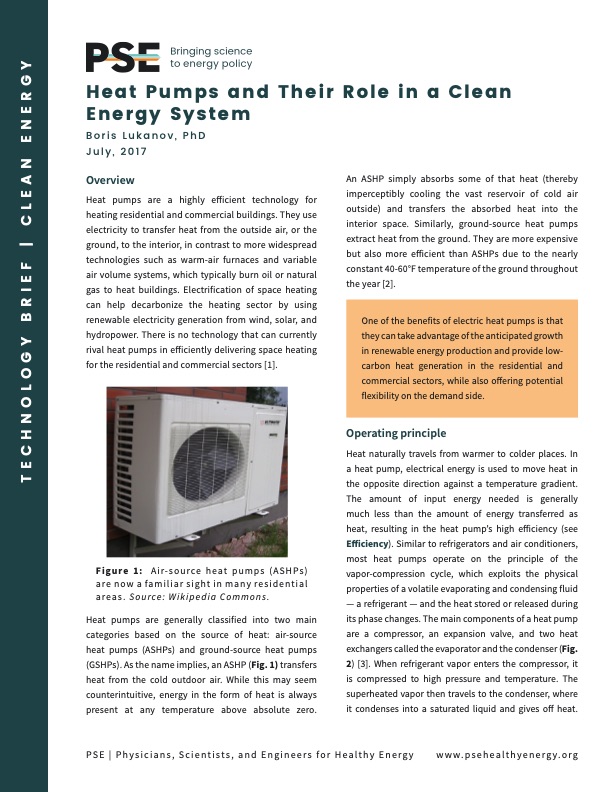
PDF Publication Title:
Text from PDF Page: 001
Heat Pumps and Their Role in a Clean Energy System Boris Lukanov, PhD July, 2017 Overview Heat pumps are a highly efficient technology for heating residential and commercial buildings. They use electricity to transfer heat from the outside air, or the ground, to the interior, in contrast to more widespread technologies such as warm-air furnaces and variable air volume systems, which typically burn oil or natural gas to heat buildings. Electrification of space heating can help decarbonize the heating sector by using renewable electricity generation from wind, solar, and hydropower. There is no technology that can currently rival heat pumps in efficiently delivering space heating for the residential and commercial sectors [1]. Figure 1: Air-source heat pumps (ASHPs) are now a familiar sight in many residential areas. Source: Wikipedia Commons. Heat pumps are generally classified into two main categories based on the source of heat: air-source heat pumps (ASHPs) and ground-source heat pumps (GSHPs). As the name implies, an ASHP (Fig. 1) transfers heat from the cold outdoor air. While this may seem counterintuitive, energy in the form of heat is always present at any temperature above absolute zero. An ASHP simply absorbs some of that heat (thereby imperceptibly cooling the vast reservoir of cold air outside) and transfers the absorbed heat into the interior space. Similarly, ground-source heat pumps extract heat from the ground. They are more expensive but also more efficient than ASHPs due to the nearly constant 40-60°F temperature of the ground throughout the year [2]. PSE | Physicians, Scientists, and Engineers for Healthy Energy www.psehealthyenergy.org One of the benefits of electric heat pumps is that they can take advantage of the anticipated growth in renewable energy production and provide low- carbon heat generation in the residential and commercial sectors, while also offering potential flexibility on the demand side. Operating principle Heat naturally travels from warmer to colder places. In a heat pump, electrical energy is used to move heat in the opposite direction against a temperature gradient. The amount of input energy needed is generally much less than the amount of energy transferred as heat, resulting in the heat pump’s high efficiency (see Efficiency). Similar to refrigerators and air conditioners, most heat pumps operate on the principle of the vapor-compression cycle, which exploits the physical properties of a volatile evaporating and condensing fluid — a refrigerant — and the heat stored or released during its phase changes. The main components of a heat pump are a compressor, an expansion valve, and two heat exchangers called the evaporator and the condenser (Fig. 2) [3]. When refrigerant vapor enters the compressor, it is compressed to high pressure and temperature. The superheated vapor then travels to the condenser, where it condenses into a saturated liquid and gives off heat. TECHNOLOGY BRIEF | CLEAN ENERGYPDF Image | Lync heat pump diagram

PDF Search Title:
Lync heat pump diagramOriginal File Name Searched:
HeatPumps.pdfDIY PDF Search: Google It | Yahoo | Bing
CO2 Organic Rankine Cycle Experimenter Platform The supercritical CO2 phase change system is both a heat pump and organic rankine cycle which can be used for those purposes and as a supercritical extractor for advanced subcritical and supercritical extraction technology. Uses include producing nanoparticles, precious metal CO2 extraction, lithium battery recycling, and other applications... More Info
Heat Pumps CO2 ORC Heat Pump System Platform More Info
| CONTACT TEL: 608-238-6001 Email: greg@infinityturbine.com | RSS | AMP |